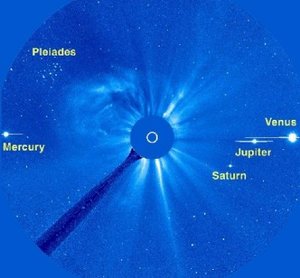10 May
1998: On 10 May 1998, ESA's Infrared Space Observatory (ISO) mission made its last observation with the Short-Wave Spectrometer (SWS) instrument. It showed emission lines from hydrogen in the hot supergiant star 'Eta Canis Majoris'.
In its time, ISO was the most sensitive infrared satellite ever launched. ISO made particularly important studies of the dusty regions of the Universe, where visible light telescopes can see nothing. The wealth of data collected by ISO still produce important science results.
The SSW instrument on ISO, which produced the final result, analysed radiation in the 2.4 to 45 micron band. It provided valuable information about the little known chemistry of the Universe, since many molecules emit light in the infrared range. The SWS was also able to study the physical conditions of those chemical constituents, such as temperature and density.
ISO was switched off six days later and its orbit was changed to force the satellite to burn up in the atmosphere, contributing to preserving the environment in space.

1900: On 10 May 1900, Cecilia Helena Payne-Gaposchkin was born. An English-born astronomer, she was the first to apply laws of atomic physics to the study of the temperature and density of stellar bodies, and the first to conclude that hydrogen and helium are the two most common elements in the Universe.
During the 1920s, the accepted explanation of the Sun's composition was a calculation of around 65% iron and 35% hydrogen. In her doctoral thesis (1925), Payne claimed that the Sun's spectrum was consistent with another solution: 99% hydrogen with helium, and just 1% iron. She had difficulty persuading her superiors to take her work seriously. It was another 20 years before Payne's original claim was confirmed, by fellow astronomer Fred Hoyle.















 Germany
Germany
 Austria
Austria
 Belgium
Belgium
 Denmark
Denmark
 Spain
Spain
 Estonia
Estonia
 Finland
Finland
 France
France
 Greece
Greece
 Hungary
Hungary
 Ireland
Ireland
 Italy
Italy
 Luxembourg
Luxembourg
 Norway
Norway
 The Netherlands
The Netherlands
 Poland
Poland
 Portugal
Portugal
 Czechia
Czechia
 Romania
Romania
 United Kingdom
United Kingdom
 Slovenia
Slovenia
 Sweden
Sweden
 Switzerland
Switzerland


































